The Blonger Bros. had more than their share of saloons,
gambling joints and other frontier businesses.

Hell On Wheels
Map of the Blonger Boomtowns
Prior to Sam and Lou's arrival in Denver, they owned saloons and other businesses in numerous boomtowns.
1868-71: Sam claimed to have a run a hotel for four years in Red Oak, Iowa. Lou worked in a billiard hall. On the rail line, and not far from Council Bluffs, the boys in all probability got to know the bunko men working the trains, men under the tutelage and protection of Ben Marks, creator of the monte store, precursor of the big store con. The following is from a speech about master con man Ben Marks by Ryan Roenfield in 1999:
During this time frame of the early 1870's, Marks was in league with a host of notable gamblers and like-minded confidence men that "roosted" in Council Bluffs and Omaha while sweeping riches away from railroad travelers. This motley group included Canada Bill Jones, a master at three-card monte who was known far and wide for his generosity; Doc Baggs; Charley White; George DeVol; the infamous Frank Tarbeaux, and an Englishman named John Bull who had won infamy in the Montana mining towns for shooting his mentor Charlie Peel dead on Helena's Main Street. In the early '70's, Marks, John Bull, Doc Baggs, and Omaha gambler George Mehaffy were all indicted in Omaha for robbing a Missourian after a card game. Worse yet, the Union Pacific banned gambling on its trains after a now nameless company official lost $1,200 to Frank Tarbeaux and "Jew" Mose. Canada Bill Jones even offered the railroad's general superintendent $10,000 a year for exclusive rights to run three-card monte games on U.P. trains if he limited his victims to Chicago businessmen and Methodist preachers. The Union Pacific declined Canada Bill's generous offer and most of the gamblers sought new opportunities in the mining towns of the Black Hills like Deadwood. But Ben Marks remained in Council Bluffs where he used his ill-gotten wealth to establish himself in politics and turn his transplanted home into a "right town," a place where the fix was covered and "con men gathered for both social and business reasons."
Red Oak may indeed have been the perfect school for a bunko education. Lou was later said by DA Van Cise to have been linked to the Council Bluffs gang run by John Maybray, and under Mark's protection in 1910 when the hammer fell and the gang went down — though connections in the U.S. Marshal's office kept Lou in the clear.
1871-74: For a few years they gravitated around the Great Salt Lake and its boomtowns, Dry Canyon and Stockton. Here they ran a variety of businesses: a beer saloon, and gambling house, canned oysters - and if Lou's obit is to be believed, they built (or were somehow involved with) the first steamboat to ply the great salt lake.
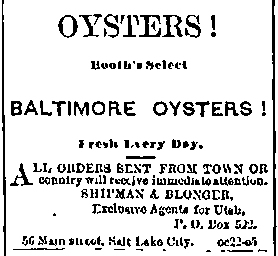 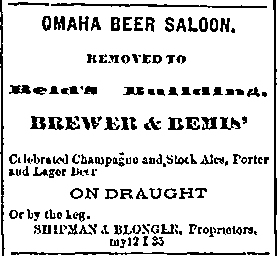
1875: Virginia City, Nevada. The year of the Great Fire, we know nothing of the Blonger's time here. Sam knew the town in its earliest days, possibly driving freight to Austin in the early 60s.
1876: Cornucopia, Nevada. Here the boys ran a saloon called The Palace. The Daily Silver State had a running local column, Letters From Cornucopia.
The Blonger Bros., Sam and Lew, who keep The Palace and patronize the State, are fixtures here and can be relied upon for square drinks.
When the honorable committee left us the Judge had two babies in his possession, which he had donated to him by Sam and Lew Blonger of The Palace. Adious, Judge; God bless you.
Sam and Lew Blonger, at The Palace, are selling whisky and cigars as usual at two bits per drink.
1877: Tuscarora, Nevada. Not far from Cornucopia, the boys had another saloon named The Palace.
Saloons were extremely popular in the mining town and Tuscarora had plenty by the fall of 1877: Progressive (Mary Schafer), Silver Brick (P.T. Leonard), Pioneer (Tollman and Hutton), C.O.D. (Huck and Thompson), Young America (D.L. Davis), Idaho (Swaggart and Rinehart), Delta (Gronsky and DeYoung) , Empire (Key and Harris), Cabinet (A.J. Dallas), Palace (L.H. Blanger [sic]), Gem (V.C. Bartlett), and Grand Prize (John Woods). In addition, the Crystal Spring Brewery opened in the Bacon brothers store. Lodging was provided at the Star Lodging House (Thomas Cockbin), Howerton Lodging House (J.C. Howerton), Wilkins Hotel (J.F. Wilkins), and the Gem Hotel. One thing Tuscarora also had was an abundant supply of attorneys: James Dow, John Rand, Wines and Dorsey, Street and Windle, A.W. Fisk, Keeney and Bigelow, J. A . Savage, C.A. Kingston, and Charles Abbot.
1878: Silver Reef, in southwestern Utah. Also, back to Salt Lake, and perhaps Dodge City as well. They were said to have run tours in Dodge at some point.
1879: Leadville — but also Denver and Georgetown. Denver's star had yet to rise; Leadville was the place to be. Sam runs for mayor, Lou runs a theater in Georgetown, and they are involved in mining.
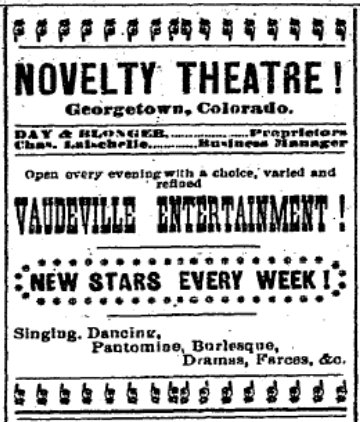
1881: The first Blonger police blotter entries in Denver, probably regarding a saloon or gambling house, are said to appear, prior to their stint in Albuquerque.
1882: Sam is marshal of New Albuquerque, and Lou plays at being deputy and detective, when not procuring for his girls. Sam's deputies and associates are a hard lot, including brother Lou and Masterson associate gambler Charlie Ronan, and their antics — which likely included bunko games — and Sam's inaction, eventually seem to have cost him his job.
1883: Newspaper ads indicate Blonger & Co. briefly ran Stroud's Theater in Phoenix, AZ. Perhaps Stroud's saloon as well. It's unclear if this refers to Sam, Lou, or both.
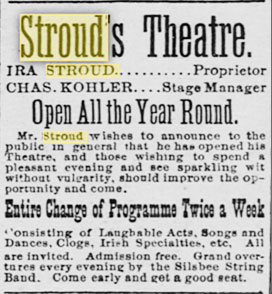
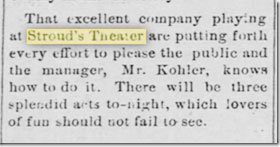
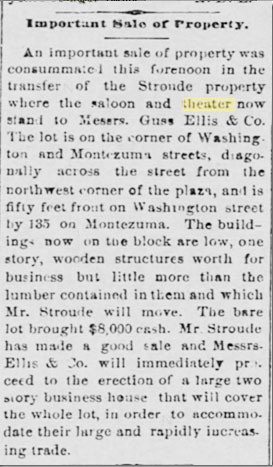
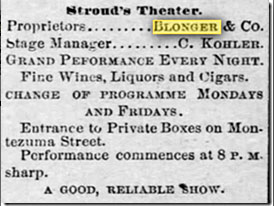
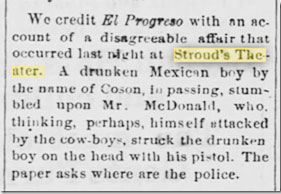
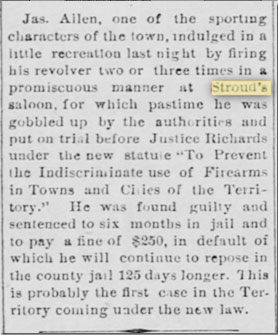
1883-87: Lou claims in his 1887 military pension form that he had resided in southern New Mexico since 1883, including Silver City, Deming and Kingston. He claims to live under the roof of gambler Frank Thurmond. What businesses might he have engaged in there? The San Bernardino voter rolls indicate Lou also spent time there, too, in 1884, running a saloon.

The Denver Joints
Map of Denver Sites
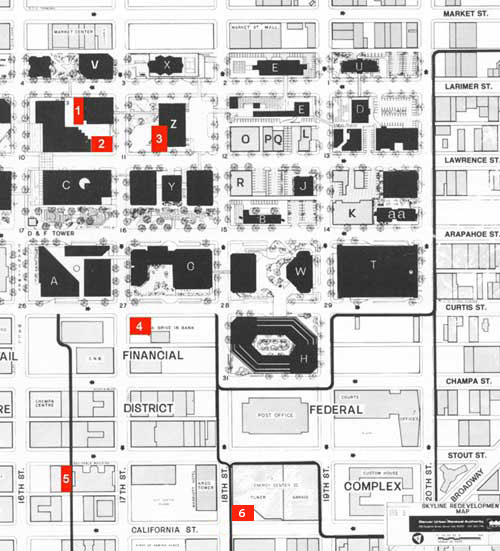
- Croff & Curtis Bldg., 1644 Larimer
- Lou's Office, American National Bank Bldg, 17th & Lawrence
- D.A.'s Observation Post, Cassidy Hick Wallpaper Co., 250 ft. north on Lawrence
- The Lookout, Rolnick Bldg., 17th & Curtis
- The Elite Saloon, Stout between 16th & 17th
- Fake Stock Exchange, The Denham Bldg., corner of 18th & California (not sure which corner)
1888: Here's Larimer as Lou would have seen it on his return to town from New Mexico.
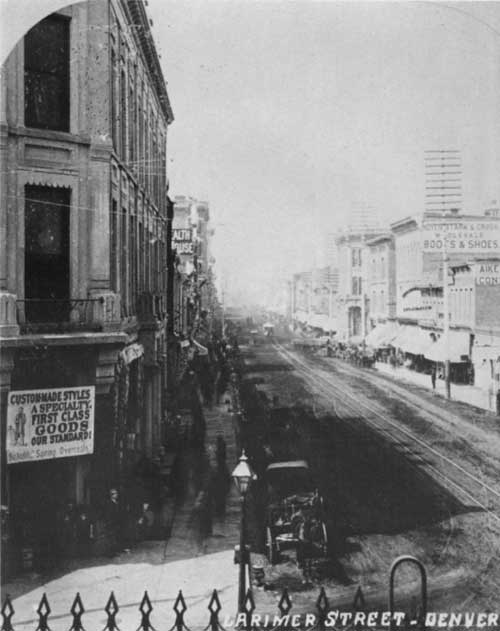
1888: Gambler Joe Thompson, self-professed cousin of gunfighter Ben Thompson, dies of a morphine overdose, and it is noted that he spent time at a gambling house run by Sam, located on 15th St. across from the post office.
1889: The city directory lists a business (Blonger Bros.?) at 1728 Larimer (Lou lives at 1732 Lawrence). 1728 Larimer St. shown below.
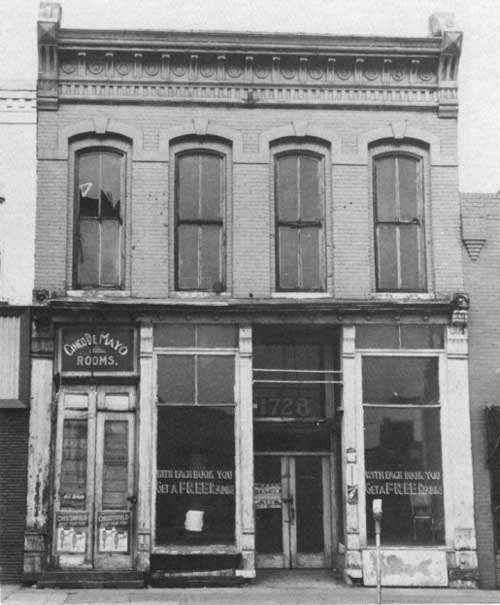
1891: The city directory lists a business at 1744 Larimer (club rooms), Lou lives at Timmerman Block. Blonger Bros. gambling house at 1744 Larimer closed for bunko games. One article from 1891 indicates the Blongers owned the Tourists Club at 1734 Larimer, though by next year it's listed at 1740.
Boulder Daily Camera, Sept. 26, 1891
Closed by the Police.
DENVER, Sept. 25.—The police board to-day ordered the gambling house of Blonger Bros., 1744 Larimer street, closed. The place is said to be a bunco joint, and the board wishes it understood it is after that sort of thing.
1892: Blonger Bros. open a saloon on Market between Sixteenth and Seventeenth. Blonger Bros. gambling house at 1744 Larimer was also closed for bunko games.
Rocky Mountain News, April 7, 1892
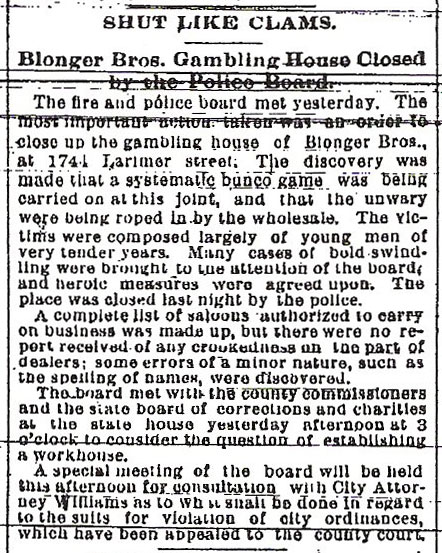
1892: The "Blonger boys" are arrested for facilitating a swindle in their Tourists Club, 1740 Larimer Street.
Rocky Mountain News, August 26, 1922
Both Lou and Sam, together with men named Walker and Phour, were captured and charged with the robbery of C. I. Tolly, a mining engineer and assayer of Longmont, Colo. Tolly had complained to the police that he had come to Denver and had been discussing a money transaction with a friend in the Markham hotel, when two men, who had been listening, approached him and began talking of mining. On the pretense of showing him some ore from Creede, they invited Tolly to walk with them to Larimer Street.
As they passed the Tourists club, the story goes, one of the men asked Tolly if he would mind stepping in for a few minutes. Tolly stood behind one of the men as they engaged with a some others in a friendly game of poker. One of the men drew three aces and a king and turning to Tolly asked him what he would bet on it. Tolly reluctantly replied that if he were playing he would put $100 on it.
The man on the other side of the table made a pretense of taking the bet. Of course, the aces and the king lost. The men then insisted that he pay, and when Tolly attempted to escape they threatened his life if he did not sign over the money. Tolly made out a check for $100 and went back to Longmont. Friends urged him to return to Denver and complain to the police. His complaint resulted in the raid.
1893: Business at 1744 Larimer (club rooms), Lou lives at 1740 Arapahoe.
Lou's obituaries say Lou and Sam's first Denver saloon was at 1644 Larimer Street in the Croff and Collins Building, next to the Cheesman Block on 17th. This saloon would have been behind, and perhaps even directly in back of, the Silver Dollar Saloon. Best evidence seems to indicate that the gambling den at 1744 Larimer lasted from around 1891 to 1893, morphing into a saloon at 1644 Larimer about 1894.
Here's the Duff Block on the left, 1744, and 1728. Where's 1740? First floor of 1742?
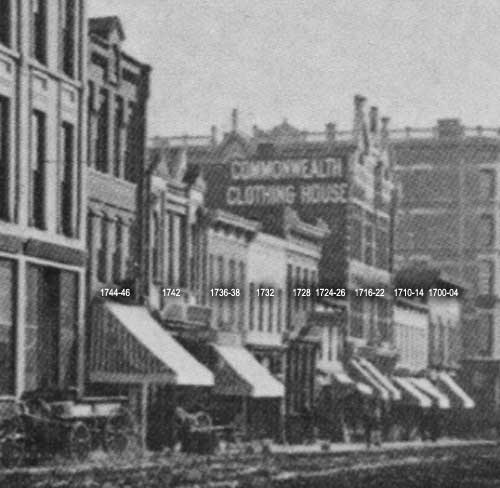
Detail from a Sanborn map, graciously provided by a spy amongst the Smiths made it possible to put addresses to the photo. Here are floor plans for the block shown above.
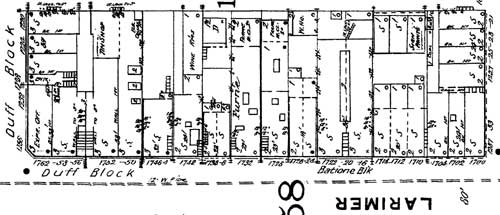
1894: Business at 1723 Larimer (club rooms), Lou lives at 1742 Arapahoe. Sam has a saloon at 1644 Larimer. Gov. Waite's newly installed police commission closes down the gamblers.
1723 Larimer, maybe indicated by the arrow.
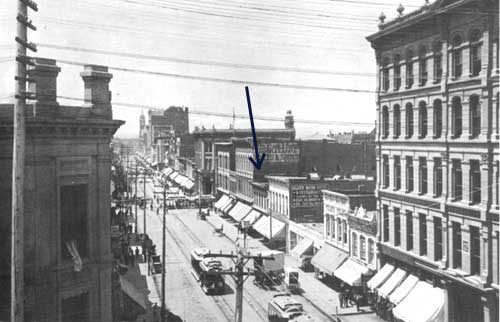
Aspen Weekly Times, April 26, 1894
Blonger's, Argyle's and other places on Larimer and Market, including Jeff Smith's Tivoli, were closed tight and so were the three policy shops on Larimer and Fifteenth streets respectively. The branch policy shops throughout the city, with a few exceptions were also closed. There were a few open till noon when the last drawing was held.
1895: Lou lives at 1761 Ogden. A campaign is launched against the Blonger resorts by the Mercury, a weekly paper devoted to the upbuilding of the populist party and the official organ of Governor Waite. The Smith brothers come looking for the Blongers at "Lew Blonger's place," 1644 Larimer.
Rocky Mountain News, April 22, 1895
While this was going on at the city hall, however, the two Smiths were not idle. Officer Kimmel met the chief and Detective Connors with them at Nineteenth and Larimer. From here he followed them down to Eighteenth, thinking that in case the Smiths gave any trouble he would be on hand to help. After Goulding and Connors left the Smiths the latter went into Blonger's place on Larimer near Seventeenth. Here they said they were looking for trouble, and became quite noisy. Officer Kimmel went into the place and told the Smiths that the noise must stop at once or there would be two arrests. This settled the Smiths to some extent, and they retired from the place, muttering maudlin apologies to the officer. They next stopped at the Arcade. Here they had a quarrel with John Hughes and Charlie Lorge, battering them both over the heads with their revolvers. Hughes received one cut over the nose that will probably mark him for life, while Lorge is said to have had serious injuries inflicted on his head. Just after this little fracas Officer Kimmel went into the place and asked what was up. He was assured that nothing was wrong, and left.
This incident led to Bascomb Smith's incarceration, and to Soapy's eventual departure. Whether the Blongers had a hand in Smith's fall from grace we do not know, but his absence apparently marked the beginnings of the Blongers dominance in Denver.
1896: Business at 1644 Larimer, Lou lives at 1761 Ogden. The Elite Saloon, "Denver's flashiest saloon," is at 1626 Stout.
Denver Evening Post, October 6, 1896
A MAGNIFICENT SALOON.
Will Be Opened by the Blongers This Evening.
Sam and Lewis Blonger open their magnificent palace saloon at 1628 Stout street, next to the Equitable Building, this evening. It is a veritable palace of luxury—mahogany fixtures and frescoed ceilings at a cost of $8,000—marble floors and an elegant cafe in the rear part of the saloon. In this cafe a fine merchants' lunch will be served from 10 a. m. to 2 p. m. and this will be one of the features of which the genial proprietors will make a specialty. The interior of the new saloon is without doubt one that will be a feast for the eyes of anyone who loves the beautiful. The marble floor will glisten with splendor this evening, and in the language of one of the proprietors, "There isn't an old thng in the house."
This evening the gentlemen in charge will make a special effort to make friends for their new palace—not that they will not always do this, for it is a fact pretty generally known among the boys that Sam and Lew are built on just such plans and specifications. Mat Murray, formerly of the Arcade, Mr. Lockney and Mr. Kelley will be the bartenders in charge, and every one of them is well known in the city as genial, gentlemanly fellows.
Rocky Mountain News, October 25, 1896
...Nowadays men drink like gentlemen and it is little wonder that when they drink they insist on surroundings befitting them. There are gentlemen in Denver who realize this truth. They are the Messrs. Blonger Brothers. They have constructed a temple—a palace—at 1624 Stout street for the accommodation of gentlemen who, for infirmities and for good fellowship, now and then indulge a cup that braces up and cheers. They have named this veritable place The Elite. There is nothing like it anywhere. There is nothing equal to it in richness of material or design or price in any other Western city. It must be seen to be appreciated...
Here's an advertisement for the Elite, featuring John McCulloch's Mountain Dew Whiskey.
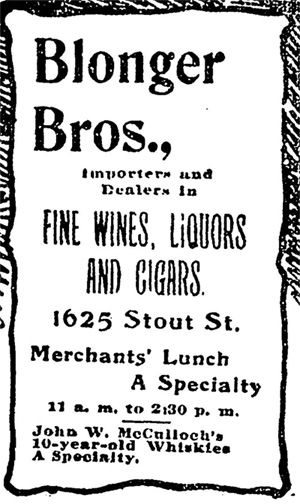
This is the Equitable Building (built in 1892). It's still there — an historic landmark. 17th Street goes left, Stout Street heads to the right. Based on our evidence, in this picture the Elite Saloon is immediately to the right of the Equitable Building.
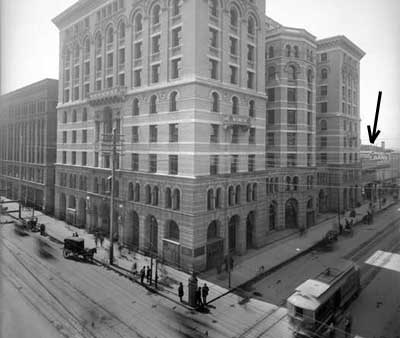
Our assumption, based on Fighting the Underworld, was that the Elite was the Blongers' outpost for many years. But the truth was, they overplayed their hand. Either Denver was not ready for a lavish drinking establishment, or the Blongers seriously overspent trying to bolster their respectability. The Elite pulled up lame coming out of the gate. It closed after only three months.
1898-00: Walker & Blonger saloon, 1863 Larimer. Samuel Walker ran a big saloon out of a two-story brick building at 2054-60 Larimer during the 1880s. In the 1889 city directory, with a business there, living at 1863 Larimer. Taking him back a bit further, he was in Denver at least by 1880. Born in Pennsylvania in 1843, making him six years older than Lou, he ran the Walker Hotel at 907 Halladay for many years before going into the saloon business.
Here's the building, on the right, that housed the Walker & Blonger saloon.
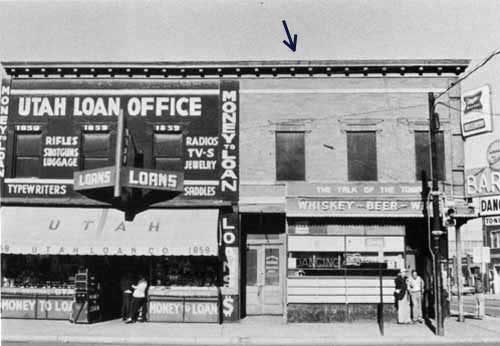
This makes a total of eight known saloons and gambling clubs in downtown Denver.
1922: Lou's office is upstairs at the American Bank Building.
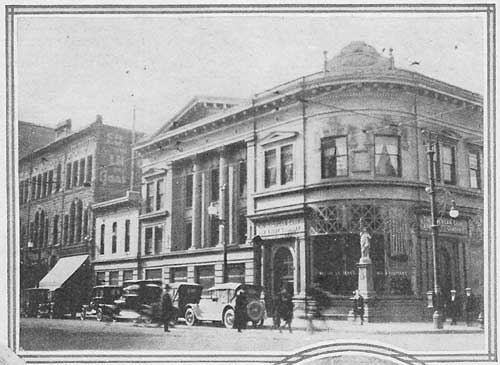
Speaking of Larimer Street — the buildings we've been talking about, the Blonger joints, are all gone now. Denver's Tenderloin district, Larimer Street and environs, is the very oldest part of town, and in the Sixties and Seventies the area was almost completely razed to make way for the modern downtown one finds there now. It's not hard to imagine that many Denverites were happy for the change:

But there were those who felt otherwise:
Your bulldozers rolling through my part of town,
The iron ball swings and knocks it all down.
You knocked down my hock shop, you knocked down my bar
and you black-topped it over to park all your cars.
And where will I go, And where can I stay?
You knocked down the skid row & hauled it away.
I'll flag a fast rattler and ride it on down, boys,
They're running the bums out of town.
Old Maxie the tailor is closing his doors,
There ain't nothing left in the second-hand stores;
You knocked down my pawn shop and the big Harbor Lights
And the old Chinese cafe that was open all night.
You ran out the hookers who worked on the street,
And you built a big club where the playboys can meet;
My bookie joint closed when your cops pulled a raid,
But you built a new hall for the stock market trade.
These little store keepers they don't stand a chance
With the big uptown bankers a-calling the dance,
With their suit-and-tie restaurants that's all owned by Greeks,
And the counterfeit hippies and their plastic boutiques.
Now I'm finding out there's just one kind of war -
It's the one going on 'tween the rich and the poor;
I don't know a lot about what you'd call class,
But the upper and middle can all kiss my ass.
Copyright ©1973, 2000 Bruce Phillips
Here's a Google-eye view of what the Tenderloin looks like today. the 1700 block of Larimer is center. 1728, 40 and 44 were on the right side of the street.
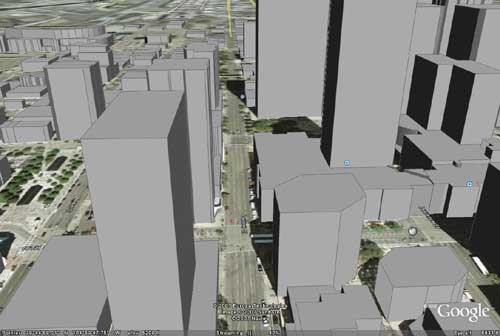
And let's not forget another famous character connected to Larimer, Jack Kerouac:
I got on that hot road, and off I went in a brand-new car driven by a Denver businessman of about thirty-five. He went seventy. I tingled all over; I counted minutes and subtracted miles. Just ahead, over the rolling wheatfields all golden beneath the distant snows of Estes, I'd be seeing old Denver at last. I pictured myself in a Denver bar that night, with all the gang, and in their eyes I would be strange and ragged and like the Prophet who has walked across the land to bring the dark Word, and the only Word I had was 'Wow!'....and before I knew it we were going over the wholesale fruitmarkets outside Denver; there were smokestacks, smoke, railyards, red-brick buildings, and the distant downtown graystone buildings, and here I was in Denver. He let me off at Larimer Street. I stumbled along with the most wicked grin of joy in the world, among the old bums and beat cowboys of Larimer Street.
Chapter 5: On the Road
The Larimer neighborhood was the boyhood home of Kerouac's companion, Neil Cassady (Dean Moriarty in the book).
Dean was the son of a wino, one of the most tottering bums of Larimer Street, and Dean had in fact been brought up generally on Larimer Street and thereabouts. He used to plead in court at the age of six to have his father set free. He used to beg in front of Larimer alleys and sneak the money back to his father, who waited among the broken bottles with an old buddy.
Chapter 6: On the Road
|



